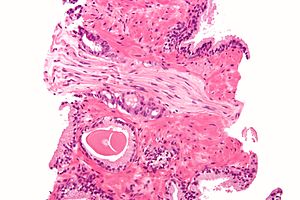The study involved high-risk men, defined as having at least 1 of the following risk factors: T3 to T4 disease, a prostate-specific antigen (PSA) level above 20 ng/mL, or a Gleason score above 7. All of the men had node-negative disease.
Survival Data and More
The 630 study participants (average age, 71 years) were randomized to either 36 or 18 months of androgen-blockade therapy, consisting of bicalutamide 50 mg (a nonsteriodal antiandrogen) for 1 month and goserelin 10.8 mg (a luteinizing hormone-releasing hormone [LHRH]) every 3 months before, during, and after pelvic and prostate radiotherapy.
From October 2000 to January 2008, 310 patients were randomized to the 36-month group and 320 to the 18-month group. Most had T2 to T3 disease.
At 5 years, overall survival in the 36-month and 18-month treatment groups was comparable (92.1% vs 86.8%; P = .052); the same was true at 10 years (63.6% vs 63.2%; P = .429).
Similarly, at 5 years, disease-specific survival in the 36-month and 18-month treatment groups was comparable (97.6% vs 96.4%; P = .473); the same was true at 10 years (87.2% vs 87.2%; P = .838).
In addition, there were no significant differences between the 2 treatment groups for a host of other measures: biochemical failure, second course of androgen blockade therapy, pelvic node metastases, bone metastases, and causes of death.
At 77 months, 71 of 310 patients (22.9%) in the 36-month group and 76 of 320 (23.8%) in the 18-month group had died (P = .802).
The main causes of death for all patients were a second cancer (7.3%), prostate cancer (4.9%), and cardiovascular disease (4.4%). Age was the only risk factor that was statistically significant in the study. "Older patients die more rapidly," said Dr. Nabid.
The combination of bicalutamide and goserelin, which is a LHRH agonist, is a strategy known as androgen blockade, and is a somewhat controversial choice, Dr. Roth told Medscape Medical News in an interview. It is "almost universal" clinical practice to either use an LHRH agonist or remove the testicles to achieve castrate levels of testosterone. But the utility of adding an antiandrogen (in this case bicalutamide) is a matter of debate, he said.......





Žádné komentáře:
Okomentovat